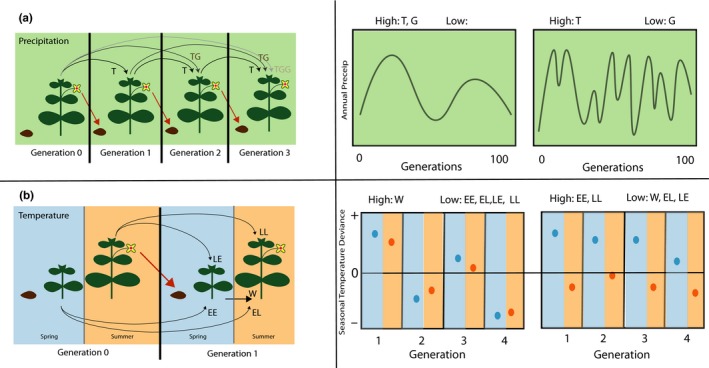Figure 1.

Schematic depicting the ecological motivations (summer annual plants) and theoretical underpinnings for the evolutionary modeling of plasticity traits (a, c), and the types of environmental fluctuations that may influence their evolution (b, d). (a) Precipitation plasticity model. The amount of precipitation experienced by an individual can lead to transgenerational effects in the next generation (T), as well as persist for two (TG) or three (TGG) generations. (b) On the left, relatively gradual decadal oscillations give value to transgenerational effects that persist for multiple seasons (T, TG, and TGG). On the right, shorter period climatic oscillations may favor parental effects (T), but not multigeneration effects (TG or TGG). (c) On the left, we see an example of an environment with high within‐season autocorrelations for temperature (hot springs tend to be followed by hot summers), but low interannual autocorrelations (a hot year does not tend to be followed by another hot year) that select for within‐generation plasticity but not transgenerational plasticity. On the right, a situation where spring and summer temperatures are not correlated with each other, but we do find that environmental oscillations lead to a string of warmer than average springs and cooler than average summers; in this situation, transgenerational plasticity (EE and LL) but not within‐generation plasticity is expected to be optimal. (d) Temperature plasticity model. In the abbreviations, E denotes the early growing season (spring), and L denotes the late growing season (summer). The first letter represents the relevant season during the parental generation, and the second letter represents the relevant season in the offspring generation (e.g., EL denotes effects of parental early growing season temperature on offspring phenotypes late in the growing season). Within‐generation developmental changes in response to early‐season environment (W) are also considered in this model. Additionally, the long‐term average environmental conditions at a specific area determine the genetic baseline phenotype of an individual (g)
